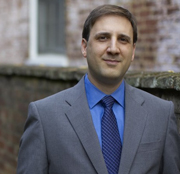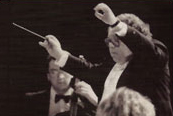The Jewish Sound in Soviet Music: Interview with James Loeffler
On Sunday, May 4, 2014 at 3:00pm, YIVO will present Open Secret: The Jewish Sound in Soviet Music, as part of its ongoing Sidney Krum Young Artists Concert Series.
Before World War II, the Soviet Union was the only country in the world to officially promote Jewish music. After World War II, Soviet authorities declared that Jewish music did not exist. Yet all along, major Soviet composers such as Dmitri Shostakovich, Miecyzslaw Weinberg, and Mikhail Gnesin found deep inspiration in the sounds of Ashkenazi Jewish folk music. How did these composers manage to weave Jewish themes into some of the most stirring music of postwar Soviet society? How did they personally navigate the ongoing strictures of artistic censorship and the periodic cycles of antisemitic repression?
In this YIVO event, Professor James Loeffler, Yuval Waldman and the young artists of the Krum Concert Series will explore these questions through a unique pairing of music and words. In a blended lecture-concert, they will present several works including Dmitri Shostakovich's String Quartet No. 8, Mikhail Gnesin's Piano Trio in Memory of Our Perished Children, and Miecyzslaw Weinberg's Rhapsody on Moldavian Themes for violin and piano.
Attend the event.
 James Loeffler
James LoefflerJames Loeffler is an Associate Professor of History and Jewish Studies at the University of Virginia. He also serves as Scholar-in-Residence at the Pro Musica Hebraica Foundation and as Academic Vice Co-Chair of the Jewish Music Forum of the American Society for Jewish Music. His first book, The Most Musical Nation: Jews and Culture in the Late Russian Empire was published by Yale University Press in 2010. It received awards from the Association for Jewish Studies, the Association for Slavic, East European, and Eurasian Studies, and the American Society of Composers, Authors & Publishers (ASCAP). In 2013-2014, he is Dean's Visiting Scholar on the Andrew Mellon Foundation New Foundations Fellowship at the Georgetown University Law Center. There he is working on a book about Jews, Israel, and international human rights.
 Yuval Waldman
Yuval WaldmanBorn in Russia and educated in Israel, the United States and Europe, Yuval Waldman has enjoyed great success as a violinist, conductor, and educator. Waldman has appeared as a soloist with orchestras in the United States, Canada, Europe and Israel and given recitals at Carnegie Hall, Lincoln Center, The Kennedy Center, Wigmore Hall in London, and Concertgebouw in Amsterdam. In 2005, Maestro Waldman founded Music Bridges International, to foster cross-cultural music exchange programs that feature the music of different countries. Under the Music Bridges banner, he organized the successful Young Artsist Strings Competition at the “Tchaikovsky’s Homeland” Center in Izhevsk/Votkinsk, Russia.
James Loeffler is interviewed here by Yedies editor, Roberta Newman.
RN: At the concert on May 4, we will be hearing the works of various Soviet composers. Two of them are Jewish but Shostakovich, of course, isn't. What links them together in this context?
JL: Jewishness in music is not a biological proposition. Russian composers as far back as Glinka and Rimsky-Korsakov found inspiration in Ashkenazi Jewish music. They produced stylized settings of folk and liturgical melodies. This tradition continued after the revolution. But in light of the new kinds of Soviet antisemitism and political debates about Jewish nationality, Jewish music took on a heightened symbolic valence. For Shostakovich, who was not Jewish, the sounds of klezmer and Yiddish folk song proved very attractive. They were an intriguing musical device—highly expressive, with touches of dissonance and exotic accents, yet grounded in a folk style familiar to Russian ears—and at the same time potent symbols of a suffering minority culture with a triumphant universal spirit. To write with Jewish themes, for both Shostakovich and his Jewish contemporaries, then, was to tap a very powerful reservoir of sounds linked to emotions and ideas that resonated with the Soviet listeners.
RN: What sorts of Jewish sources did Shostakovich, Weinberg, and Gnesin mine for inspiration and what opportunities did they have to encounter this music?
JL: Gnesin and Weinberg grew up intimately exposed to traditional Jewish music. Gnesin was the grandson of Shayke Fayfer, a famous itinerant Yiddish street singer in nineteenth-century Vilna; Weinberg was the son of a klezmer violinist and Warsaw Yiddish theater director. But all three encountered this music also through the folksong collections of zamlers [collectors] and composers associated with the prerevolutionary Society for Jewish Folk Music and its Soviet-era successor, the Society for Jewish Music. Printed collections of transcribed melodies and popular songs circulated widely among composers. Composers such as Shostakovich also heard this music in formal concerts held at the conservatories in the 1910s and 1920s, including evenings of Jewish symphonic works, and of course in phonograph recordings. The close associations between all three composers and the Jewish artists and intellectuals associated with the Moscow Yiddish theater, including Shloyme Mikhoels, also exposed them to a great deal of folk culture. Finally, the ethnographer, writer and critic Yehezkel Dobrushin (1883-1953) provided Gnesin and Shostakovich with source material used in their compositions.
RN: In what ways did the Soviet Union promote Jewish music before World War II? What happened after the war?
JL: Before World War II, the Soviet Union practiced a form of state support for Jewish national culture. Composers such as Gnesin were allowed to relaunch prerevolutionary Jewish cultural societies, including one devoted to Jewish music. The state publishing house issued Jewish compositions and concerts were held of new Jewish music. Symphonies appeared, and even several brief-lived attempts at opera. In the republics, Jewish musical ensembles were created, including a large klezmer ensemble and a Yiddish choral group. Recordings and published songbooks spread the music throughout the population. And of course, the Yiddish state theaters in cities such as Moscow, Kiev, and Minsk drew on the talents of Jewish composers to create elaborate scores for new productions.
Much of this activity slowed down under ideological pressure in the 1930s. But it returned during World War II, as Stalin encouraged the Jewish artistic intelligentsia to mobilize the Jewish population and prepare culture in order to show allies in the West that the regime was philo-Semitic and determined to combat Nazi antisemitism. This phase continued right up until 1948, when the anti-cosmopolitanism campaign began to target Jewish cultural figures and explicitly linked Jewish national culture to Zionism, Israel, and the West. Soon editorials in Pravda and elsewhere began to condemn Jewish artists for disloyalty. Purges began at the conservatories and music schools. Arrests soon followed. Even after Stalin's death, Jewish music entered an era of official non-existence. Even the term itself was purged from Soviet scholarly works. And yet, it never disappeared completely. In the former shtetls of Soviet Ukraine, klezmer music continued to surface at weddings after the war. In the late 1950s and early 1960s, the Soviet authorities began to allow concerts of Yiddish folk songs in the Baltics and elsewhere. In this way, younger Soviet Jews began to reconnect with their heritage, learn of the Holocaust, and nurture dreams of cultural freedom.
RN: Some of the pieces that will be presented commemorate the Holocaust. They were composed in an era in which the specifically Jewish experience in the Holocaust was officially downplayed in the Soviet Union. How did these composers walk this ideological tightrope?
JL: The key to the ideological tightrope of Soviet music was ambiguity. In his works, Shostakovich often layered traditional Jewish melodies on top of modernist passages that turned them into dissonant abstractions. This made it harder to pin down the political or programmatic meaning of the pieces. Everyone could hear something Jewish in the music, but it never announced itself as about the Jews or the Holocaust. (The exception, of course, was the Babi Yar symphony, but that came later, in the early 1960s).
Similarly, Weinberg played games with titles and assumptions to disguise some of his work. Other nationalities were permitted and encouraged to cultivate their national traditions in art music, but after the war Jewish music became ideologically suspect, so Weinberg titled his sonata based on Jewish klezmer motives the Rhapsody on Moldavian Themes. He cleverly took advantage of the fact that klezmer and Moldovan folk music do share many musical similarities. This allowed Weinberg to hide his music in plain view. Gnesin titled his trio In Memory of Our Perished Children, without specifying if these children were Jewish or Soviet. This strategic ambiguity allowed listeners—and commissars—to interpret the work as a generic depiction of Soviet war suffering, while Jewish listeners could identify with both the general Soviet experience and the particular Jewish loss—especially because of a musical clue that Gnesin embedded in his music, through a surreptitious quotation from a Yiddish folk song about a Jewish parent mourning the death of his son.
Read an article on Jewish Concert Music by James Loeffler in The YIVO Encyclopedia of Jews in Eastern Europe.




